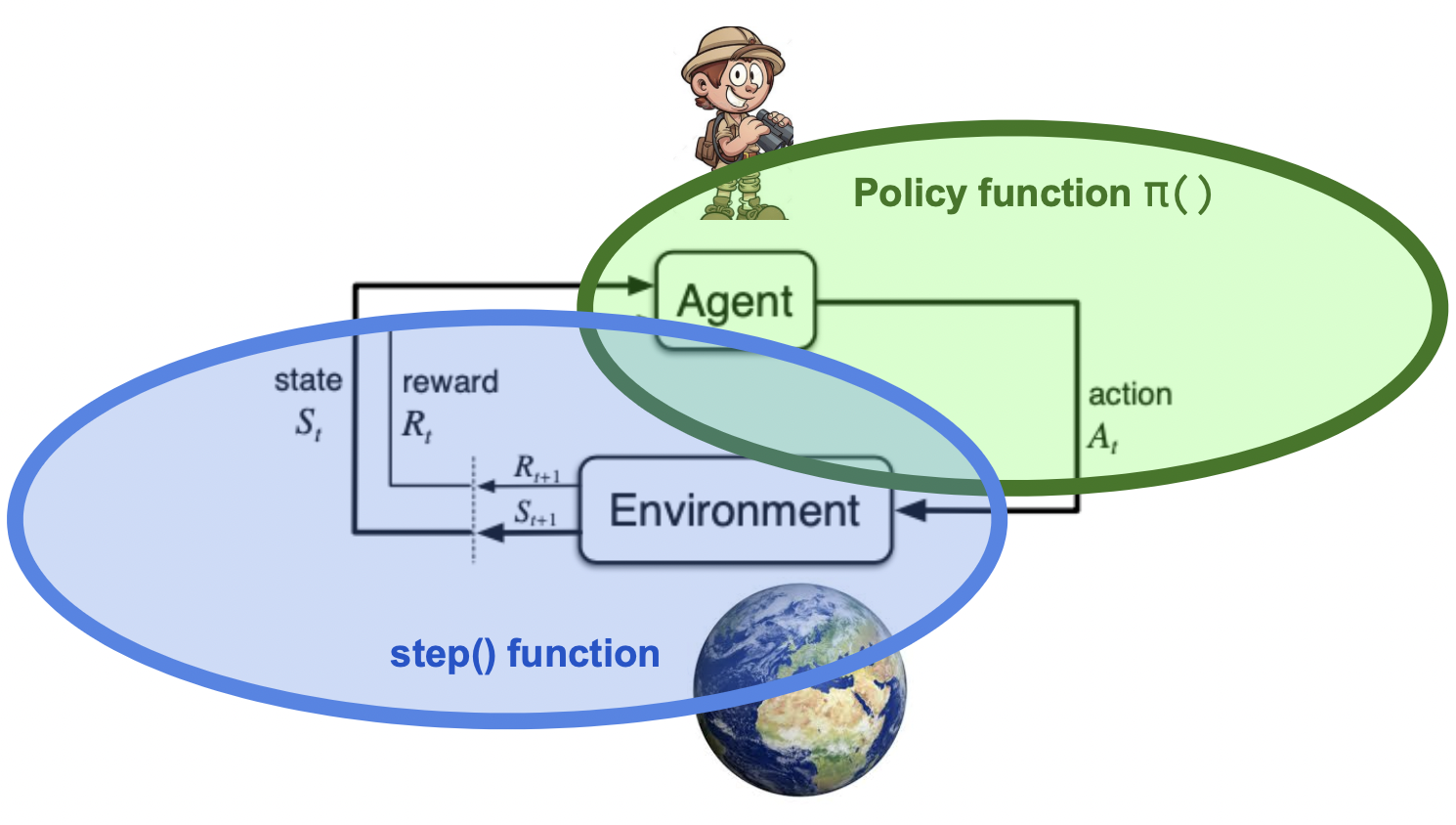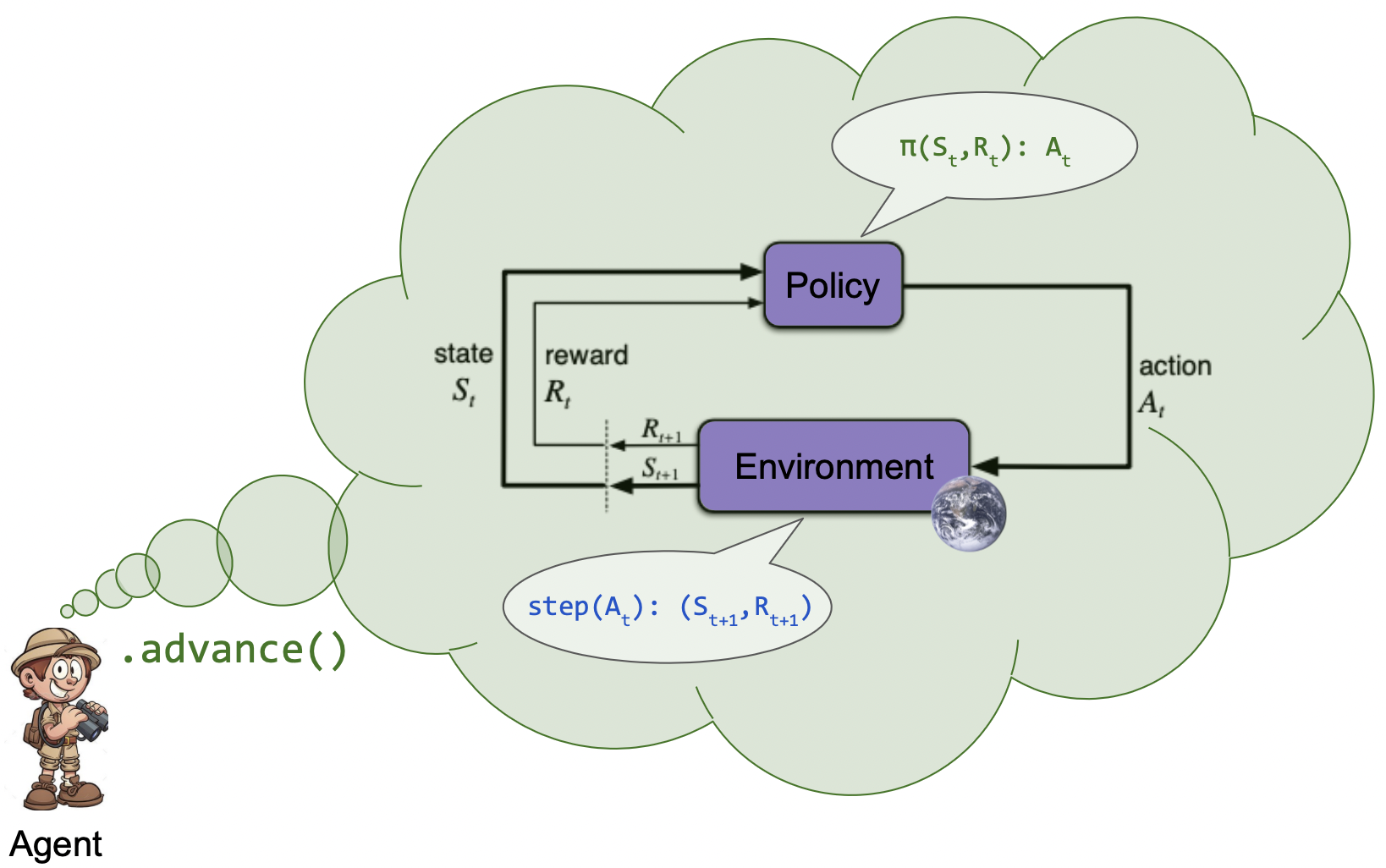Architecture and Design
Background from Reinforcement Learning
In Reinforcement Learning (RL), the basic control loop is between agent and
environment, as shown in fig_trad_rl_arch. An environment (or env) is
a stateful object analogous to a simplified version of the world we live in. In
a programming language, an Env (e.g., OpenAI’s gym.Env) is often an object with
a step() function that takes an action and returns an observation (or
“state”) and reward.
An agent encapsulates the ability to make a decision and act in that env. An agent usually contains a policy which is a function that takes an (observation, reward) pair and returns an action.

The traditional RL view of the loop between Agent (green) and Environment (blue). The information that passes between them at a given time step t includes: action At, state (a.k.a, observation) St, and reward Rt. Image modified from Sutton & Barto figure 3.1 (pg 48).
AgentOS Concepts
The RL concepts of an agent and its environment, as described above are
very similar to those in AgentOS. However, AgentOS differs from the classic RL
architecture in a few key ways. First, an agent is paired with – and holds a
reference to – its environment. Second, the agent also can hold a policy.
Finally, the agent has an advance() function, inside of which it takes one
step around the core RL loop between the agent’s policy and its environment.

The concepts are very similar in AgentOS, though AgentOS also differentiates
between an agent and a policy, and formalizes the relationship between agent,
policy, and environment: an agent has a policy and an environment connected
in a message passing loop. Calling agent.advance() causes a single
iteration of that loop to occur.
In terms of design philosophy, environments, policies, and agents are:
Stateful - an environment tracks internal state (e.g. location of objects in a room), a policy often maintains a machine learning model which can be updated to reflect past learnings; an agent maintains a policy, an environment, as well as arbitrary other state (e.g. recent observations from its env, memory modules, etc.);
Flexible and minimal - minimal APIs result in minimal constraints on developers. For example, developers can choose their own concurrency model, architecture, algorithms, etc.
The following are high-level descriptions of key AgentOS concepts.
AgentOS. A project that contains tools, APIs, and conventions for building, managing, and sharing learning agents.
Environment. Environments have step() and reset() functions as they
are defined in gym.Env. We recommend making a class that inherits from
gym.Env.
Policy. Policies have a compute_action() function which the agent can
use to decide on their next action, given the most recent observation returned
from the agent’s environment.
Agent. A Python class that has an advance() function that returns a
boolean, and encapsulates the agent behavior necessary to take steps in its
environment:
choose actions (e.g. a policy)
takes actions by calling
self.env.step()learn from – or otherwise updates internal state based on – return value of
self.env.step()
AgentOS provides agentos.Agent as a reference implementation of an abstract
agent base class. A running agent is called an agent instance.
Agent Runner. Code that runs an agent by calling agent.advance() till
it returns True. It might also instantiate the agent (or it might take an
agent instance).
CLI. The Command Line Interface provides some basic commands for creating and running an AgentOS agent, mostly for learning AgentOS.
Agent directory. A directory with standard files needed by AgentOS CLI to create or run an agent using MLflow. Also known as agent project.
Architecture
fig_architecture shows the main AgentOS architectural components.

The basic architecture of AgentOS.
Modes of Interacting with AgentOS
Agents, policies, environments, etc. are written in Python. Agent instances can
be run via Python in scripts or interactively with agentos.run_agent() or
via the CLI.
- The CLI supports a few basic commands:
agentos init- create files that define an example agent in the current directory.agentos run- run an agent. Supports a few convenient ways to specify the agent class and env class that make up the agent instance. If called without any args, tries to run the current dir as an MLflow project, else looks for agent and env class definitions in agent.py. Under the hood, regardless of which argument option is used,agentos.run_agent()is called. See the pydocs for full details.